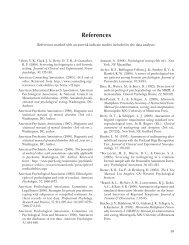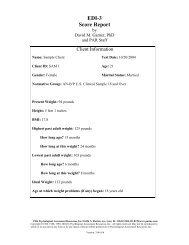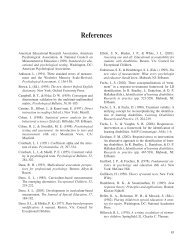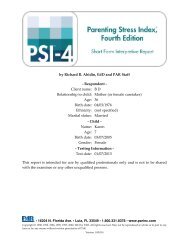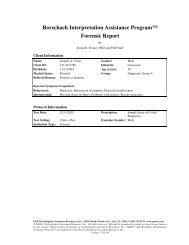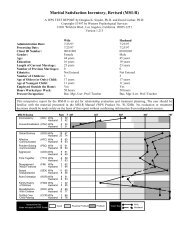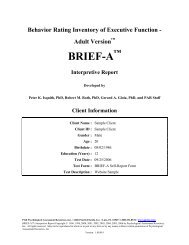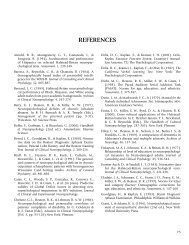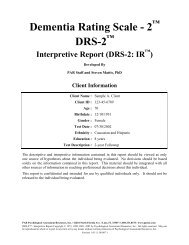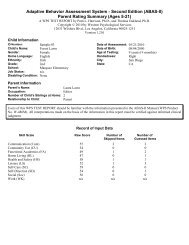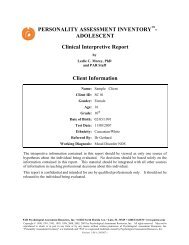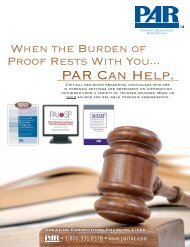MMPI -2 Adult Interpretive System Version 4 Content-Based Report
MMPI -2 Adult Interpretive System Version 4 Content-Based Report
MMPI -2 Adult Interpretive System Version 4 Content-Based Report
- No tags were found...
Create successful ePaper yourself
Turn your PDF publications into a flip-book with our unique Google optimized e-Paper software.
<strong>MMPI</strong> ® -2<strong>Adult</strong> <strong>Interpretive</strong> <strong>System</strong> <strong>Version</strong> 4<strong>Content</strong>-<strong>Based</strong> <strong>Report</strong>Developed byRoger L. Greene, PhDand PAR StaffClient InformationName: sample CaseClient ID: SC2011Gender: MaleAge: 32Education: High School Grad.Ethnicity: Caucasian/WhiteTest Date: 09/13/2010The interpretive information contained in this report should be viewed as only one sourceof hypothesis about the individual being evaluated. No decisions should be based solely onthe information contained in this report. This material should be integrated with all othersources of information in reaching professional decisions about this individual. This reportis confidential and intended for use by qualified professionals only. It should not bereleased to the individual being evaluated.PAR / 16204 N. Florida Ave. / Lutz, FL 33549 / 1.800.331.8378 / www.parinc.comCopyright© 1998, 2000, 2006,2008, 2010 by PAR. All rights reserved. May not be reproduced in whole or in part in any form or by anymeans without written permission of PAR. <strong>MMPI</strong> is a registered trademark of the University of Minnesota.<strong>Version</strong>: 5.00.018
Client: sample Case Test Date: 09/13/2010ID#: SC2011 Page 2 of 28Potential Impact of Demographic VariablesThe client’s age, education, and ethnicity are unlikely to have a significant impact on theinterpretation of the <strong>MMPI</strong>-2 scores.
Client: sample Case Test Date: 09/13/2010ID#: SC2011 Page 3 of 28Dangerousness to Self ItemsAge Group: 30-39 YearsHis responses (either “True” or “Omitted”) to the Dangerousness to Self items (150, 303,506, 520, 524, 530) should be documented in writing in his clinical record.Dangerousness to Self - ResponsesTest item number Client responseTypical percentendorsed TRUE150 FALSE 9.81303 FALSE 8.24506 FALSE 14.21520 FALSE 9.33524 FALSE 6.37530 FALSE 2.83Number of itemsendorsed TRUEDangerousness to Self - Item CountNumber endorsedby this clientTypical percentendorsing thisnumber0 X 77.741 9.942 4.653 3.124 2.715 1.376 0.47
Client: sample Case Test Date: 09/13/2010ID#: SC2011 Page 4 of 28Dangerousness to Others ItemsAge Group: 30-39 YearsHis responses (either “True” or “Omitted”) to the Dangerousness to Others items (150, 540,548) should be documented in writing in his clinical record.Dangerousness to Others - ResponsesTest item number Client responseTypical percentendorsed TRUE150 FALSE 9.81540 FALSE 10.16548 FALSE 15.36Dangerousness to Others - Item CountNumber of itemsendorsed TRUENumber endorsedby this clientTypical percentendorsing thisnumber0 X 74.571 17.562 6.363 1.50
Client: sample Case Test Date: 09/13/2010ID#: SC2011 Page 5 of 28OmissionsHe omitted no items.Consistency of Item EndorsementTest-Taking BehaviorsHe endorsed the items consistently (VRIN 38-60, TRIN 83).Accuracy of Item EndorsementHe has endorsed the items accurately (L < 61, F < 95, K 36-57). There are no indicationsof either a very positive or negative self-description that would impact the interpretation of the<strong>MMPI</strong>-2.
Client: sample Case Test Date: 09/13/2010ID#: SC2011 Page 6 of 28Moods<strong>MMPI</strong>-2 <strong>Content</strong>-<strong>Based</strong>Negative Emotionality and General Subjective Distress (A): He has a normal level ofgeneral subjective distress and negative affect (A = 45 - 57).Anxiety (ANX): ANX 64.Depression (Scale 2 (D)): He exhibits a general sadness and depressed mood abouteither life or himself. The clinician can determine the source of this depressed mood eitherthrough direct inquiry or by examining his scores on the other clinical scales. The higher thisscore, the more pervasive pessimism, depression, and hopelessness are in his life (Scale 2 (D) >64). If he has not reported suicidal ideation (150F, 303F, 506F 520F, 530F), it is important tore-evaluate the safety and risk factors for suicidal behavior because of his depressive mood.Anger and Irritability (ANG): ANG 1 64. He also describes himself as being irritable,grouchy, impatient, hotheaded, annoyed, and stubborn (ANG 2 > 64).Fears (FRS): FRS 64. FRS 1 64. FRS 2 64.Hypomania (Scale 9 (Ma)): Scale 9 (Ma) 64.CognitionsProblems with Attention, Concentration, and Memory (Sc 3 ): Sc 3 69.Cynical Beliefs (CYN): CYN 64. CYN 1 64. CYN 2 64.Antisocial Attitudes (ASP 1 ): ASP 1 64.Negative Cognitions (LSE 1 ): LSE 1 64.Psychotic Symptoms and Behaviors (BIZ): BIZ 64. BIZ 1 64. BIZ 2 64.Interpersonal RelationsSocial Introversion (Scale 0 (Si)): Scale 0 (Si) < 64.Family Problems (FAM): He reports considerable familial discord and strife. Hisfamily is lacking love, support, and companionship, and he likely wants or wanted to leavehome (FAM 1 > 64). He is alienated from and unattached to his family. He does not see hisfamily as a source of support (FAM 2 > 64).Social Alienation (Pd 4 ): Pd 4 69.Delinquency/Antisocial Behavior (ASP 2 ): ASP 2 64.Other Problem AreasSomatic Symptoms (HEA): HEA 64. He reports specific gastrointestinal symptomssuch as nausea and vomiting (HEA 1 > 64). HEA 2 64. He worries about his health and aboutcatching disease. He believes that he is experiencing poor health (HEA 3 > 64).Alcohol/Drug Abuse (AAS): AAS 64.Suicidal Ideation: No Suicidal items were endorsed.Sleep Problems: There was not a significant number of items endorsed.Sexual Concerns: (L&W Critical Items endorsed: 12F, 34F, 268T.) He reportsconcern about his sexual behavior and may have been in trouble because of his sexual behavior.
Client: sample Case Test Date: 09/13/2010ID#: SC2011 Page 7 of 28
Client: sample Case Test Date: 09/13/2010ID#: SC2011 Page 8 of 28Validity and K-Corrected Clinical Scales120120110110100100909080Pd80D70706060VRINHyPaPtMaFB50TRINLHs50FFpSc40KSMfSi403030Scale VRIN TRIN F FB Fp L K S Hs D Hy Pd Mf Pa Pt Sc Ma SiT score 54 50 48 51 48 48 43 42 51 74 57 77 44 57 55 47 56 43Client Profile
Client: sample Case Test Date: 09/13/2010ID#: SC2011 Page 9 of 28Restructured Clinical (RC) Scales120120110110100100909080807070RC4RC960RC1RC760RCdRC2RC6RC85050RC340403030Scale RCd RC1 RC2 RC3 RC4 RC6 RC7 RC8 RC9T score 58 58 53 47 62 56 58 56 61Client Profile
Client: sample Case Test Date: 09/13/2010ID#: SC2011 Page 10 of 28<strong>Content</strong> Scales1201201101101001009090TPA80FAM8070ANG70DEP60ANXOBSTRT60HEABIZWRK5050FRSCYNASPLSE4040SOD3030Scale ANX FRS OBS DEP HEA BIZ ANG CYN ASP TPA LSE SOD FAM WRK TRTT score 60 48 59 63 58 57 67 49 47 81 48 39 77 56 61Client Profile
Client: sample Case Test Date: 09/13/2010ID#: SC2011 Page 11 of 28Supplementary Scales120120110110100100909080MDS80APSMAC_R7070MtPK60AAAS60Ho5050EsGMRReGF40O_H40Do3030Scale A R Es Do Re Mt PK MDS Ho O_H MAC_R AAS APS GM GFT score 56 45 47 36 45 65 63 79 56 41 71 60 73 48 44Client Profile
Client: sample Case Test Date: 09/13/2010ID#: SC2011 Page 12 of 28Personality Psychopathology Five (PSY-5) Scales120120110110100100909080807070NEGE60PSYC60AGGR5050DISC40INTR403030Scale AGGR PSYC DISC NEGE INTRT score 54 59 44 64 41Client Profile
Client: sample Case Test Date: 09/13/2010ID#: SC2011 Page 13 of 28Harris-Lingoes and Social Introversion Subscales120120110110100100D39090Pd5808070Hy3Pd170D560D1D4Pd4Pa1Sc5Ma2Ma460Hy1Sc150D2Hy4Hy5Pd2Pd3Pa2Pa3Sc3Sc4Sc6Si15040Hy2Sc2Ma1Ma3Si2Si3403030Scale D1 D2 D3 D4 D5 Hy1 Hy2 Hy3 Hy4 Hy5 Pd1 Pd2 Pd3 Pd4 Pd5 Pa1 Pa2 Pa3 Sc1 Sc2 Sc3 Sc4 Sc5 Sc6 Ma1 Ma2 Ma3 Ma4 Si1 Si2 Si3T score 64 48 91 62 66 56 43 70 48 48 71 47 51 66 82 64 48 51 55 40 48 49 61 46 42 63 41 63 43 39 41Client Profile
Client: sample Case Test Date: 09/13/2010ID#: SC2011 Page 14 of 28<strong>Content</strong> Component Scales12012011011010010090908080FAM270DEP3HEA1HEA3BIZ1ANG2TPA1TPA2FAM170DEP260DEP4TRT160ANG1FRS2CYN250FRS1BIZ2CYN1ASP1LSE2TRT250HEA2DEP1ASP2LSE140SOD240SOD13030Scale FRS1 FRS2 DEP1 DEP2 DEP3 DEP4 HEA1 HEA2 HEA3 BIZ1 BIZ2 ANG1 ANG2 CYN1 CYN2 ASP1 ASP2 TPA1 TPA2 LSE1 LSE2 SOD1 SOD2 FAM1 FAM2 TRT1 TRT2T score 53 53 45 62 66 62 70 47 72 64 54 58 67 50 53 49 45 68 71 44 48 39 41 65 76 60 52Client Profile
Client: sample Case Test Date: 09/13/2010ID#: SC2011 Page 15 of 28Scale-by-Scale InterpretationValidity ScalesCannot Say (?)? = 0 (Raw Score)No items were omitted.Variable Response Inconsistency (VRIN)VRIN = 54He has made a typical number of inconsistent responses.Infrequency (F)F = 48He is reporting a typical number of unusual experiences.Back Infrequency (F B )F B = 51He is reporting a typical number of unusual experiences.Infrequency-Psychopathology (F P )F P = 48He has endorsed the items accurately. Scale interpretation may proceed with confidence.Symptom Validity (FBS)FBS = 48No significant elevation was reported.Lie (L)L = 48He is able to achieve an appropriate balance between admitting and denying minor socialfaults. He may be a sophisticated person who is attempting to create a favorable self-image.Correction (K)K = 43He has limited personal resources and is experiencing severe distress that is being openlyacknowledged, but he lacks either the interpersonal skills or the techniques necessary to alter thesituation. This score may also indicate that he tends to be excessively open and revealing. Inlower socioeconomic class clients, this evaluation reflects a moderate disturbance, whereas inhigher socioeconomic class clients, it reflects poor coping skills and more serious distress. Theprognosis for a psychological intervention is guarded.
Client: sample Case Test Date: 09/13/2010ID#: SC2011 Page 16 of 28Superlative (S)S = 42He is reporting emotional distress and a number of unusual behaviors and symptoms. Heclearly has not made a self-favorable reporting of psychopathology.
Client: sample Case Test Date: 09/13/2010ID#: SC2011 Page 17 of 28Clinical ScalesScale 1 (Hs)Scale 1 (Hs) = 51Other Problem Areas: He is reporting a typical number of physical symptoms.Scale 2 (D)Scale 2 (D) = 74Moods: He exhibits a general sadness and depressed mood about either life or himself. Theclinician can determine the source of this depressed mood either through direct inquiry or byexamining his scores on the other clinical scales. The higher this score, the more pervasivepessimism, depression, and hopelessness are in his life. If he has not reported suicidal ideation(150F, 303F, 506F, 520F, 530F), it is important to re-evaluate the safety and risk factors forsuicidal behavior because of his depressive moods. Cognitions: If these are significant parts ofhis life, he tends to be guilty and self-deprecating and to generally view the world in negativeterms. Interpersonal Relations: He withdraws from and frequently avoids social interactionbecause of his pessimistic views of life.Scale 3 (Hy)Scale 3 (Hy) = 57Cognitions: He has an appropriate understanding of the motives of other people; he is neithertoo trusting nor too mistrusting. Other Problem Areas: He has a typical number of concernsabout his physical functioning.Scale 4 (Pd)Scale 4 (Pd) = 77Cognitions: He is likely to be unreliable, egocentric, and irresponsible. He may be unable tolearn from experience or to plan ahead. Interpersonal Relations: He is fighting againstsomething, which is usually some form of conflict with members of his family or with authorityfigures. These conflicts may not necessarily be acted out overtly, but the rebelliousness andanger toward others can be readily apparent even in these cases. He has a good social façade andmakes a good initial impression, but the problematic features in his interpersonal relationshipswill surface in longer interactions or under stress. Treatment: Psychological interventions areless effective than maturation in achieving change. Group therapy with similar individuals isoften beneficial.Scale 5 (Mf)Scale 5 (Mf) = 44Interpersonal Relations: He identifies very strongly with the traditional masculine role, andhe may be very focused on and inflexible about his masculinity.Scale 6 (Pa)Scale 6 (Pa) = 57Cognitions: He thinks clearly and rationally. Interpersonal Relations: He is interpersonallysensitive.
Client: sample Case Test Date: 09/13/2010ID#: SC2011 Page 18 of 28Scale 7 (Pt)Scale 7 (Pt) = 55Moods: He can handle work and personal responsibilities without undue worry or anxiety.Scale 8 (Sc)Scale 8 (Sc) = 47Interpersonal Relations: He reports a typical number of concerns about himself and how herelates to others. In addition, people with chronic schizophrenia who have adjusted to and arenot experiencing distress from their psychotic process also may obtain a T score between 45 and57.Scale 9 (Ma)Scale 9 (Ma) = 56Moods: Normal college students and adolescents obtain T scores between 45 and 57, or evenslightly higher. He has a normal activity level.Scale 0 (Si)Scale 0 (Si) = 43Interpersonal Relations: He is socially extroverted, gregarious, and socially poised. If he hasan extremely low score (T < 35), he may have very superficial social relationships without anyreal depth. Treatment: The clinician should be very cautious of labeling these clients as havingschizophrenia.
Client: sample Case Test Date: 09/13/2010ID#: SC2011 Page 19 of 28Clinical SubscalesHarris-Lingoes SubscalesSubjective Depression (D 1 )D 1 = 64Psychomotor Retardation (D 2 )D 2 = 48Physical Malfunctioning (D 3 )D 3 = 91He is preoccupied with health and physical functioning, and he typically reports a widevariety of specific physical symptoms.Mental Dullness (D 4 )D 4 = 62Brooding (D 5 )D 5 = 66Denial of Social Anxiety (Hy 1 )Hy 1 = 56He is socially extroverted and comfortable around other people. He is not easily influencedby social standards and customs.Need for Affection (Hy 2 )Hy 2 = 43Lassitude-Malaise (Hy 3 )Hy 3 = 70He generally feels unhappy, uncomfortable, and in poor health. He presents vague physicalsymptoms, including weakness and fatigue, and is concerned about functioning below par bothphysically and mentally. He may have a poor appetite and problems in sleeping.Somatic Complaints (Hy 4 )Hy 4 = 48Inhibition of Aggression (Hy 5 )Hy 5 = 48Familial Discord (Pd 1 )Pd 1 = 71He views his home situation as unpleasant and lacking in love, support, and understanding.He describes his family as rejecting, critical, and controlling.
Client: sample Case Test Date: 09/13/2010ID#: SC2011 Page 20 of 28Authority Problems (Pd 2 )Pd 2 = 47Social Imperturbability (Pd 3 )Pd 3 = 51Social Alienation (Pd 4 )Pd 4 = 66Self-Alienation (Pd 5 )Pd 5 = 82He describes himself as feeling uncomfortable and unhappy. He has problems inconcentration and attention, and he does not find his life to be especially interesting orrewarding. He verbalizes guilt and regret and displays negative emotions in an exhibitionisticmanner. Alcohol abuse may be a problem.Persecutory Ideas (Pa 1 )Pa 1 = 64Poignancy (Pa 2 )Pa 2 = 48Naїveté (Pa 3 )Pa 3 = 51Social Alienation (Sc 1 )Sc 1 = 55Emotional Alienation (Sc 2 )Sc 2 = 40He does not report feelings of depression and despair. He is not apathetic, and he feels thatlife is worth living.Lack of Ego Mastery, Cognitive (Sc 3 )Sc 3 = 48He is not concerned about his thought processes, feelings of unreality, or problems inconcentration and attention.Lack of Ego Mastery, Conative (Sc 4 )Sc 4 = 49He does not report depression or worry. He finds his everyday life interesting, and he seemsto have the energy to cope with everyday problems.Lack of Ego Mastery, Defective Inhibition (Sc 5 )Sc 5 = 61Bizarre Sensory Experiences (Sc 6 )Sc 6 = 46He does not report neuralgic symptoms, feelings of depersonalization, or other strangeexperiences.Amorality (Ma 1 )Ma 1 = 42He sees other people and himself as honest and concerned.
Client: sample Case Test Date: 09/13/2010ID#: SC2011 Page 21 of 28Psychomotor Acceleration (Ma 2 )Ma 2 = 63Imperturbability (Ma 3 )Ma 3 = 41Ego Inflation (Ma 4 )Ma 4 = 63Social Introversion SubscalesShyness/Self-Consciousness (Si 1 )Si 1 = 43He is comfortable interacting with others.Social Avoidance (Si 2 )Si 2 = 39He likes to be with groups of people and will seek them out if given the opportunity.Alienation-Self and Others (Si 3 )Si 3 = 41He has confidence in himself and his activities.
Client: sample Case Test Date: 09/13/2010ID#: SC2011 Page 22 of 28Restructured Clinical (RC) ScalesDemoralization (RCd)RCd = 58Somatic Complaints (RC1)RC1 = 58Low Positive Emotions (RC2)RC2 = 53Cynicism (RC3)RC3 = 47Antisocial Behavior (RC4)RC4 = 62Ideas of Persecution (RC6)RC6 = 56Dysfunctional Negative Emotions (RC7)RC7 = 58Aberrant Experiences (RC8)RC8 = 56Hypomanic Activation (RC9)RC9 = 61
Client: sample Case Test Date: 09/13/2010ID#: SC2011 Page 23 of 28<strong>Content</strong> and <strong>Content</strong> Component ScalesAnxiety (ANX)ANX = 60Fears (FRS)FRS = 48Generalized Fearfulness (FRS 1 )FRS 1 = 53Multiple Fears (FRS 2 )FRS 2 = 53Obsessions (OBS)OBS = 59Depression (DEP)DEP = 63Lack of Drive (DEP 1 )DEP 1 = 45Dysphoria (DEP 2 )DEP 2 = 62Self-Depreciation (DEP 3 )DEP 3 = 66He finds his life empty and meaningless. He cries easily and is self-critical and guilty.Suicidal Ideation (DEP 4 )DEP 4 = 62Health Concerns (HEA)HEA = 58Gastrointestinal Symptoms (HEA 1 )HEA 1 = 70He reports specific gastrointestinal symptoms such as nausea and vomiting.Neurological Symptoms (HEA 2 )HEA 2 = 47General Health Concerns (HEA 3 )HEA 3 = 72He worries about his health and about catching disease. He believes that he is experiencingpoor health.
Client: sample Case Test Date: 09/13/2010ID#: SC2011 Page 24 of 28Bizarre Mentation (BIZ)BIZ = 57Psychotic Symptomatology (BIZ 1 )BIZ 1 = 64Schizotypal Characteristics (BIZ 2 )BIZ 2 = 54Anger (ANG)ANG = 67Explosive Behavior (ANG 1 )ANG 1 = 58Irritability (ANG 2 )ANG 2 = 67He describes himself as being irritable, grouchy, impatient, hotheaded, annoyed, andstubborn.Cynicism (CYN)CYN = 49Misanthropic Beliefs (CYN 1 )CYN 1 = 50Interpersonal Suspiciousness (CYN 2 )CYN 2 = 53Antisocial Practices (ASP)ASP = 47Antisocial Attitudes (ASP 1 )ASP 1 = 49Antisocial Behavior (ASP 2 )ASP 2 = 45Type A (TPA)TPA = 81Impatience (TPA 1 )TPA 1 = 68He does not like to wait or to be interrupted and frequently becomes impatient, grouchy,irritable, and annoyed.Competitive Drive (TPA 2 )TPA 2 = 71He is hard-driving, fast-moving, and work-oriented and is seen as someone willing to doanything necessary to succeed.
Client: sample Case Test Date: 09/13/2010ID#: SC2011 Page 25 of 28Low Self-Esteem (LSE)LSE = 48Self-Doubt (LSE 1 )LSE 1 = 44Submissiveness (LSE 2 )LSE 2 = 48Social Discomfort (SOD)SOD = 39Introversion (SOD 1 )SOD 1 = 39Shyness (SOD 2 )SOD 2 = 41Family Problems (FAM)FAM = 77Family Discord (FAM 1 )FAM 1 = 65He reports considerable familial discord and strife. His family is lacking love, support, andcompanionship, and he likely wants or wanted to leave home.Familial Alienation (FAM 2 )FAM 2 = 76He is alienated from and unattached to his family. He does not see his family as a source ofsupport.Work Interference (WRK)WRK = 56Negative Treatment Indicators (TRT)TRT = 61Low Motivation (TRT 1 )TRT 1 = 60Inability to Disclose (TRT 2 )TRT 2 = 52
Client: sample Case Test Date: 09/13/2010ID#: SC2011 Page 26 of 28Supplementary ScalesBroad Personality CharacteristicsAnxiety (A)A = 56Moods: He has a normal level of general subjective distress and negative affect.Repression (R)R = 45Cognitions: He shows an appropriate level of willingness to discuss his behavior andproblems.Ego Strength (Es)Es = 47Moods: He is reporting a normal level of general subjective distress and negative affect.Dominance (Do)Do = 36Cognitions: He lacks confidence in his abilities to overcome any obstacles that he mayencounter. Interpersonal Relations: He prefers to have others take responsibility for his life.Social Responsibility (Re)Re = 45Interpersonal Relations: He had a variety of behavior problems while he was in school. Hehas antisocial attitudes.Generalized Emotional DistressCollege Maladjustment (Mt)Mt = 65Moods: He is generally emotionally distressed, anxious, and lacking confidence in hisabilities. Because of this discomfort, he is likely motivated to enter into psychological treatment.Post-Traumatic Stress Disorder-Keane (PK)PK = 63Moods: He is reporting some general subjective distress and negative affect that shouldmotivate him to seek psychological treatment.Marital Distress (MDS)MDS = 79Moods: He is generally emotionally distressed, anxious, and lacking confidence in hisabilities. Because of this discomfort, he is likely motivated to enter into psychological treatment.Behavioral DyscontrolHostility (Ho)Ho = 56Moods: He is reporting a typical level of distress.
Client: sample Case Test Date: 09/13/2010ID#: SC2011 Page 27 of 28Overcontrolled Hostility (O-H)O-H = 41Moods: He is able to acknowledge that he is nervous, and he worries about what happensaround him. He is aware of being angry and irritable.MacAndrew Alcoholism-Revised (MAC-R)MAC-R = 71Interpersonal Relations: He is an extroverted risk-taker who is impulsive andsensation-seeking. Other Problem Areas: If he abuses substances, he will prefer alcohol orstimulants, and he is likely to be a primary alcoholic.Addiction Admission (AAS)AAS = 60Other Problem Areas: He is reporting some use of alcohol and/or drugs. It is important todetermine whether his use of alcohol and/or drugs is problematic and whether it reflects ongoingor earlier behavior patterns.Addiction Potential (APS)APS = 73Moods: He is generally distressed and upset as well as angry and resentful. Cognitions: Hedescribes himself in negative terms and he is concerned about what others think of him. OtherProblem Areas: He is prone to abuse alcohol and/or drugs.Gender RoleGender Role-Masculine (GM)GM = 48Interpersonal Relations: He has a typical level of masculine interests and engagement inmasculine activities.Gender Role-Feminine (GF)GF = 44Interpersonal Relations: He has little interest in typical feminine activities. Other ProblemAreas: He may abuse substances.
Client: sample Case Test Date: 09/13/2010ID#: SC2011 Page 28 of 28Personality Psychopathology Five (PSY-5) ScalesAggressiveness (AGGR)AGGR = 54Psychoticism (PSYC)PSYC = 59Disconstraint (DISC)DISC = 44Negative Emotionality/Neuroticism (NEGE)NEGE = 64Introversion/Low Positive Emotionality (INTR)INTR = 41End of <strong>Report</strong>



